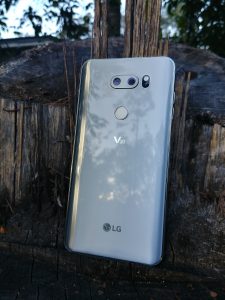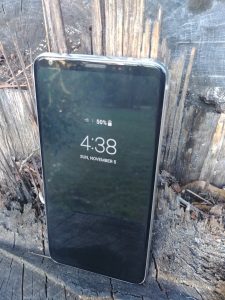LG V30: Reinventing the V Series!
 As a previous owner of both the LG V10 and V20, I was thrilled when LG announced the V30. LG made several changes to various key features with the V30 when comparing it to older models. LG removed the rugged design of the V20 (unfortunately), and the secondary screen is also now gone (good riddance). But overall, I feel the V30 is much improved over earlier generations.
As a previous owner of both the LG V10 and V20, I was thrilled when LG announced the V30. LG made several changes to various key features with the V30 when comparing it to older models. LG removed the rugged design of the V20 (unfortunately), and the secondary screen is also now gone (good riddance). But overall, I feel the V30 is much improved over earlier generations.
The V30 has specs on par with other premium phones in 2017. It comes with an octa-core Snapdragon 835, 4GB of RAM, an Adreno 540, and 64GB of internal storage (expandable via MicroSD). It has a 6-inch LED screen protected with Gorilla Glass 5 and an 18:9 aspect ratio, and minimal bezels. Rounding out the front of the device is a 5-megapixel front-facing camera.
On the back of the phone is a rear-mounted fingerprint scanner that doubles as the power button. The V30 features a dual camera setup with a primary 16-megapixel lens with Optical Image Stabilization (OIS) and a secondary 13-megapixel wide-angle lens.
Thankfully, one of the unique features carried over from the earlier generations is the headphone jack. It comes with a built-in Quad-DAC to improve the audio quality. For the first time in the V series, LG has included wireless charging to go along with the USB-C port. Also new to the V series is the IP-68 water resistance rating, thanks to the now non-removable battery.
Appearance wise, the V30 is basically a larger G6. While the combination of aluminum wrapped in glass, may look more premium, I enjoyed the rugged feel of the older style and am a little nervous to use this phone without a case. The 18:9 aspect ratio with the 6” screen is the ideal combination. It’s not too tall, nor is it too narrow. I can still use it one-handed and reach the status bar, which I cannot do on the awkward Samsung Galaxy Note 8. The rear-mounted fingerprint scanner is in the ideal place, below the rear cameras where my fingers naturally gravitate when holding the phone. The fingerprint scanner immediately unlocks the phone with no delay, as 2017 flagships should.
The display is always a vital part of any flagship phone, and the V30 mostly excels. The display covers most of the front of the phone. Where the usable screen ends, the glass curves for a smooth design. Thankfully, LG did not use the display on the curved edges (looking at you Samsung)! It looks good, but it makes it more difficult to find cases that protect the edge.
 I am happy LG has made the switch to LED. Outside in direct sunlight, the screen is much more visible and vibrant than the old LCD displays. This is especially important to me since I live in “The Sunshine State.” The LG V30 comes with the same screen as the Google Pixel 2 XL. If you’ve been following the news, there have been several issues with the Pixel 2 XL’s display. Fortunately, LG does not have those same issues with the V30. There is a noticeable change in colors at extreme viewing angles, but it is not as severe as the Pixel 2 XL.
I am happy LG has made the switch to LED. Outside in direct sunlight, the screen is much more visible and vibrant than the old LCD displays. This is especially important to me since I live in “The Sunshine State.” The LG V30 comes with the same screen as the Google Pixel 2 XL. If you’ve been following the news, there have been several issues with the Pixel 2 XL’s display. Fortunately, LG does not have those same issues with the V30. There is a noticeable change in colors at extreme viewing angles, but it is not as severe as the Pixel 2 XL.
The V30 comes with a Snapdragon 835 and it really makes this phone fly! It was a vast improvement over the Snapdragon 820 that was in the V20, and the Snapdragon 821 in the LG G6. Last year the V20 was the first phone to ship with Nougat 7.0. I was disappointed that the V30 shipped with Android Nougat 7.1.2. I had hoped the V30 would be on the most recent software as well. Hopefully, it sees Oreo 8.0 by the end of the year. One feature I love is the LG theme engine. It allows users to customize the look of their device and to get rid of the default white theme. If you would like some themes, please check out the ones I have posted in the Play Store.
Battery life has been the most surprising improvement to me so far. I always have had to charge my phone during the day in order to make it to bedtime. Sometimes more than once. I easily achieve four hours screen on time daily and last 16 hours off the charger with no issues. With the V20 I always had terrible battery life, no matter if the screen was on or off. That’s no longer an issue on the V30. Another extra benefit is the wireless charging. It is more convenient, but you will sacrifice the speed you get from plugging into a Quick Charge 3.0 charger.
The camera has impressed me for the most part. It takes high-quality photographs and easily creates the bokeh effect you can get from a DLSR camera. The low light performance is improved, along with the overall quality. Usually, smartphone cameras fail miserably at concerts, having difficulty finding the right balance with the light constantly changing. Even in auto mode, the V30 seems to do a better job at adjusting. I haven’t really dug deep into the camera features yet, but there are many options LG has added for both photos and videos. The front-facing camera is ok at best, with the only real upside being it that it offers the wide angle option that they have done in the past.
Overall I feel the V30 is setting the bar for LG in all aspects, completely reinventing the V series with staying true to some of the features of the originals. If your focus when shopping for a smartphone includes high-quality photo, video, and audio with a headphone jack I highly recommend this phone. I wish U.S. carriers would give LG more of a chance instead of focusing all efforts towards Apple and Samsung, considering T-Mobile didn’t even receive the V30 the weekend of launch and most stores only had a small display for them. If you can find one, I think you will be pleasantly surprised with the reinvented V series.




